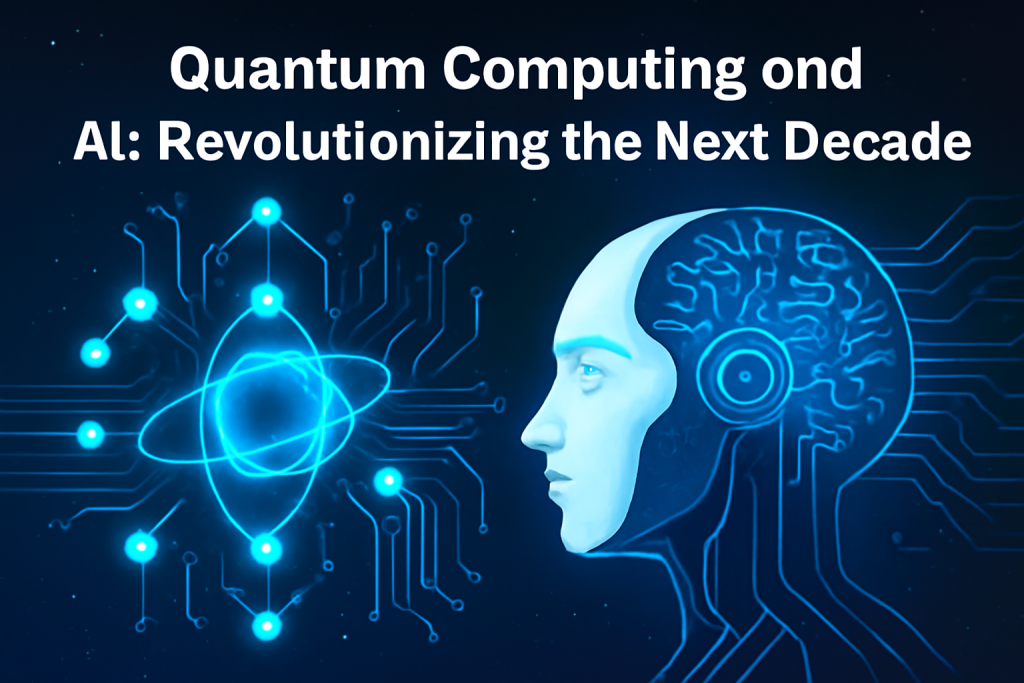
Introduction
Quantum computing and artificial intelligence (AI) are two of the most groundbreaking technologies of our time. While quantum computing has been on the horizon for decades, it’s only in recent years that we’ve started to see real strides toward making it a practical tool for solving complex problems. AI, on the other hand, has already made significant impacts across industries, from healthcare to finance, through machine learning, deep learning, and natural language processing. But when these two technologies intersect, they have the potential to reshape how we solve problems, think about computation, and even understand the world around us. This blog delves into how the synergy of quantum computing and AI will transform industries over the next decade.
In this article, we’ll explore the fundamentals of quantum computing, how it differs from classical computing, and how it will work in tandem with AI. We’ll also take a look at the potential benefits, challenges, and real-world applications that could emerge in the next ten years. By the end, you’ll understand why quantum computing and AI together represent not just an evolution, but a revolution in technology.
What is Quantum Computing?
Quantum computing is an area of computer science and physics that takes advantage of quantum mechanics to process information in ways that classical computers cannot. Classical computers process data as bits, which can either be a 0 or a 1. However, quantum computers use qubits, which can exist simultaneously in multiple states due to a principle called superposition. This means that a quantum computer can process a vast number of possibilities at the same time, exponentially increasing its potential computational power.
A fundamental property of quantum computing is entanglement, a phenomenon where the states of two qubits become linked, such that the state of one qubit can instantly affect the state of the other, even across vast distances. This ability to create complex interconnections between qubits allows quantum computers to tackle problems that classical computers struggle with, especially those requiring massive parallel processing.
To understand how quantum computing differs from traditional computing, it’s important to first grasp how classical computers work. Classical computers use bits—the smallest unit of data—which represent a binary state: either a 0 or a 1. These bits form the foundation of all operations, including arithmetic, data storage, and communication. Classical computers process these bits through logic gates to perform complex tasks. The more bits a system has, the more information it can process.
On the other hand, quantum computing operates on qubits. A qubit can represent both 0 and 1 simultaneously due to superposition, which means a quantum computer can process multiple calculations at once. This significantly accelerates the ability to solve complex problems that would take classical computers years, if not centuries.
The Mechanics Behind Quantum Algorithms
Quantum computers rely on quantum algorithms to solve problems. Shor’s algorithm, for example, is known for its ability to factor large numbers exponentially faster than the best-known classical algorithms. This is particularly significant for fields like cryptography, where the security of encryption methods often relies on the difficulty of factoring large prime numbers.
Another well-known quantum algorithm is Grover’s algorithm, which can search through unsorted databases quadratically faster than classical search algorithms. These breakthroughs in algorithm efficiency are just the beginning of what quantum computing can potentially bring to various industries.
However, quantum computing faces significant challenges. One of the most prominent is decoherence, where the delicate quantum states of qubits are easily disturbed by external influences, such as temperature and electromagnetic fields. This causes quantum information to degrade, making it difficult to maintain the accuracy of computations. Additionally, building scalable quantum hardware is still in its infancy, with researchers trying to overcome issues like qubit error rates and maintaining coherence over long periods.
Despite these hurdles, major tech companies and startups are aggressively investing in quantum computing research. Companies like IBM, Google, and Microsoft are leading the charge, with Google famously claiming to have achieved quantum supremacy in 2019, where they demonstrated a quantum computer outperforming the best classical supercomputer at a specific task.
Artificial Intelligence – The Current State
Artificial Intelligence (AI) is a branch of computer science that aims to create machines capable of performing tasks that typically require human intelligence, such as learning, reasoning, problem-solving, and natural language understanding. In recent years, AI has progressed rapidly thanks to advancements in machine learning (ML) and deep learning (DL), which use large datasets to train models and make predictions or decisions based on input data.
AI algorithms can be divided into several categories, with supervised learning, unsupervised learning, and reinforcement learning being the most prominent. Supervised learning involves training a model on labeled data, where the algorithm learns to predict an output based on the input. In contrast, unsupervised learning deals with finding hidden patterns in data without predefined labels. Finally, reinforcement learning involves training an agent to make a sequence of decisions by rewarding it for correct actions and penalizing it for wrong ones, which is often used in robotics and game playing.
The most significant advancement in AI in recent years has been the rise of deep learning. Deep learning models, like neural networks, have revolutionized areas such as speech recognition, computer vision, and natural language processing. Neural networks are designed to mimic the structure of the human brain, with layers of interconnected nodes (or “neurons”) that process data in complex ways. Deep learning has achieved remarkable success in tasks such as image classification, natural language understanding, and even generating creative content like art and music.
Despite its successes, AI still faces several challenges, such as issues of bias, transparency, and interpretability. Many AI models, particularly deep learning systems, are often considered black boxes because it’s difficult to understand how they arrive at their decisions. This has raised concerns in areas like healthcare, finance, and criminal justice, where the consequences of AI decisions can have significant real-world implications.
How Quantum Computing Enhances AI
The convergence of quantum computing and AI holds immense promise, especially for enhancing the capabilities of AI. Traditional AI algorithms, even those based on deep learning, are limited by the computational power of classical computers. As AI models grow larger and more complex, they require increasingly powerful hardware to process the vast amounts of data needed for training. This is where quantum computing comes into play.
Quantum computing offers the potential to speed up optimization problems, which are at the heart of many AI algorithms. For example, AI systems often rely on optimization techniques to fine-tune their parameters to improve accuracy. Traditional optimization methods can take a long time when working with complex models, but quantum computers could solve these optimization problems much faster using algorithms like Quantum Approximate Optimization Algorithm (QAOA).
Additionally, quantum computers can potentially accelerate machine learning itself. Quantum machine learning (QML) algorithms use the principles of quantum mechanics to process and analyze data in ways that are fundamentally different from classical methods. For instance, quantum-enhanced neural networks are being explored to increase the speed and efficiency of training AI models, reducing the time it takes to develop AI applications.
Moreover, quantum computers could dramatically improve the performance of AI in areas such as natural language processing (NLP) and computer vision, where high-dimensional data must be processed efficiently. For example, quantum computers can model complex interactions between large datasets more effectively than classical machines.
While we’re still in the early stages of integrating quantum computing with AI, the potential for breakthroughs is immense. Google, IBM, and Microsoft have all begun exploring how quantum computing can help improve machine learning, and the field is rapidly advancing. One notable example is Quantum-enhanced Reinforcement Learning, which could lead to faster and more effective learning algorithms for robotics and autonomous systems.
Potential Real-World Applications in the Next Decade
The next decade promises to bring quantum computing and AI together in ways that will revolutionize industries and change how we solve some of the world’s most pressing problems. Here are a few potential applications that could emerge:
1. Healthcare and Drug Discovery
Quantum computing could significantly enhance AI’s ability to analyze complex biological data and predict how different molecules will interact. This could accelerate the drug discovery process, which is typically slow and expensive. Quantum algorithms could help simulate molecular interactions more accurately, helping researchers identify promising drug candidates faster.
Additionally, AI, powered by quantum computing, could improve the development of personalized medicine. By analyzing vast amounts of patient data, AI could create customized treatment plans for individuals, leading to better health outcomes.
2. Financial Services and Risk Analysis
In finance, AI is already used for algorithmic trading, fraud detection, and risk assessment. By combining AI with quantum computing, financial institutions could improve predictive models and speed up data analysis, allowing for better risk management and decision-making. Quantum-enhanced AI could also optimize portfolios more efficiently and accurately.
3. Cybersecurity
Quantum computing poses both a threat and an opportunity in the realm of cybersecurity. On one hand, it could break current encryption techniques, but on the other hand, quantum computing could lead to the development of quantum-resistant encryption methods. AI, coupled with quantum computing, could create more secure communication protocols and identify vulnerabilities in networks faster.
4. Supply Chain and Logistics
AI has already revolutionized supply chain management, optimizing everything from inventory to demand forecasting. By integrating quantum computing, these systems could become even more efficient. Quantum optimization techniques could help companies solve complex routing and logistics problems faster, reducing costs and improving delivery times.
5. Climate Change and Environmental Modeling
Quantum-enhanced AI could help simulate and predict climate patterns with much greater accuracy. This could improve climate modeling and help policymakers make better decisions regarding environmental regulations and mitigation strategies.
Conclusion
The fusion of quantum computing and AI is poised to change the world in ways we can’t yet fully comprehend. While we’re still in the early stages, the potential for transformative breakthroughs is enormous. As quantum computing matures and AI continues to evolve, industries from healthcare to finance, from cybersecurity to climate science, will see dramatic improvements.
However, there are challenges ahead, including the need for better quantum hardware, the integration of quantum and classical systems, and addressing the ethical implications of advanced AI. But with continued research, investment, and collaboration, we can expect to see the quantum computing and AI revolution unfold in the next decade, ushering in a new era of innovation and problem-solving.


Leave a Reply